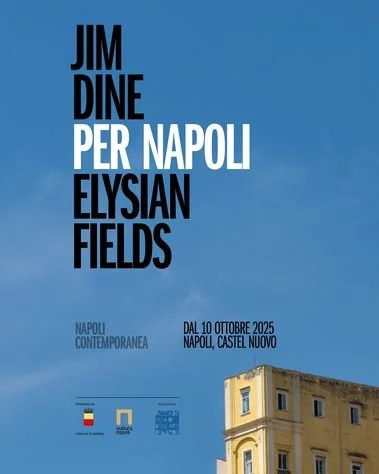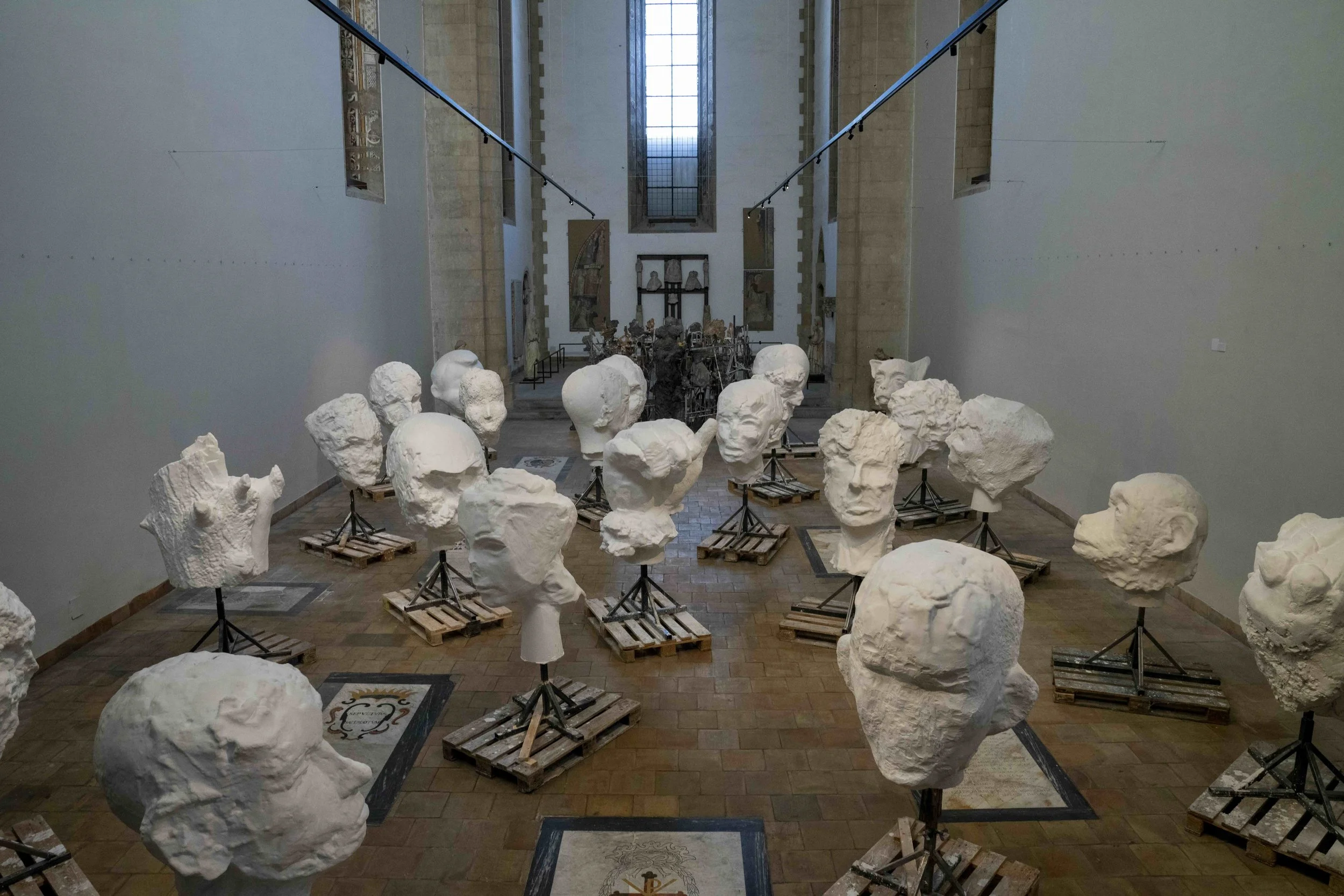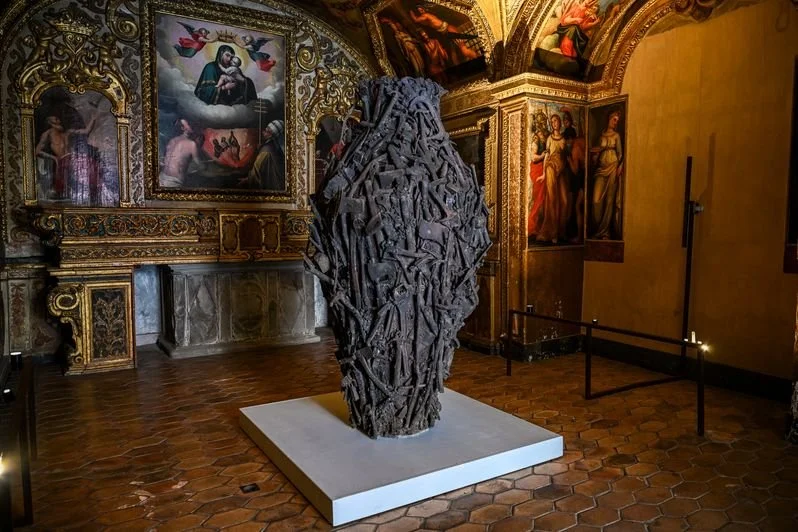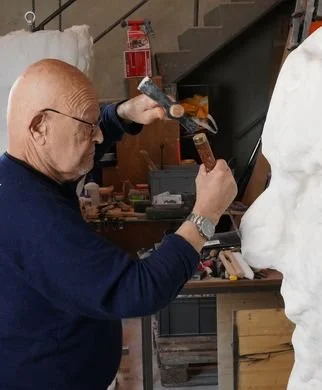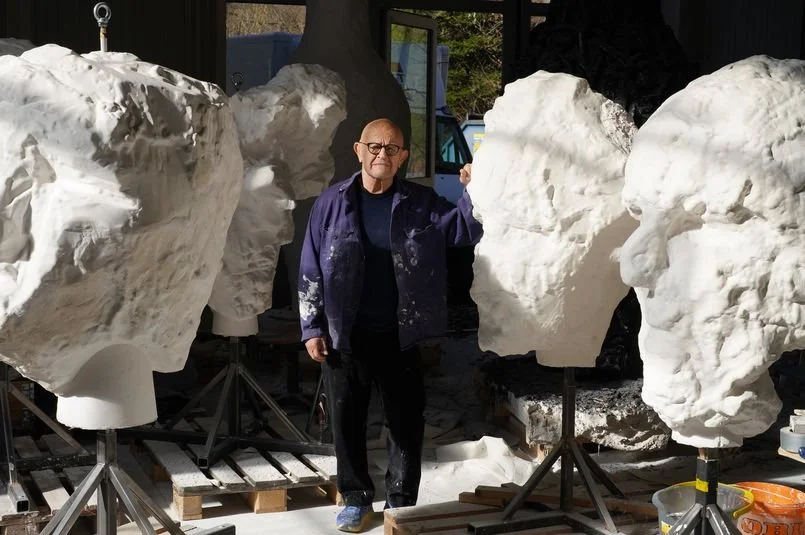For “Napoli Contemporanea 2025,” from October 10 “Elysian Fields” by Jim Dine (Castel Nuovo, October 10 – February 10)
By Giulia Orlando and Tommaso Sarasini • September 28, 2025
Elysian Fields, the site-specific exhibition set up in Castel Nuovo by the American artist Jim Dine, one of the masters of Pop Art, will be inaugurated on 10 October 2025.
The exhibition, which will be open from 10 October 2025 to 10 February 2026, is the new event of Napoli Contemporanea 2025, the programme of exhibitions and installations promoted by Mayor Gaetano Manfredi and curated by Vincenzo Trione, the Mayor's advisor for contemporary art and museum activities, which from 2023 aims to strengthen the city's vocation for contemporary art with projects conceived by protagonists of the art of our time for museum sites and for urban public spaces.
The exhibition will be housed in the monumental rooms on the ground floor of the castle (recently renovated for the exhibition “Mimmo Jodice. Metaphysical Naples”), establishing a dialogue between the historical-architectural heritage of Castel Nuovo and the contemporaneity of the American master's works.
The exhibition's 29 installations will be located in the Chapel of the Souls in Purgatory, the Palatine Chapel, the Armoury, and two additional rooms in the archaeological area. They will interact with seven Renaissance sculptures—already present in the museum but not exhibited for years due to conservation reasons—connecting different eras and artistic languages, offering the public an immersive and multifaceted experience. Furthermore, the restoration of some of the museum's works will offer a concrete opportunity to improve their state of conservation, with a view to enhancing their value.
The main space of the exhibition will be the 14th-century Palatine Chapel: 23 large sculptures by Dine, depicting classically inspired heads (“ Elysian Fields ”), will be installed along the Angevin nave. These will be joined by “The Gate Where Venus Sleeps,” a bronze and steel door leading to the apse, exhibited for the first time. The Chapel will also house several Renaissance sculptures, including Madonnas and Child by Francesco Laurana and Domenico Gagini, from the chapel itself and the adjoining sacristy. For the occasion, these recovered works will be placed on new bases, specially designed to blend in with the exhibition spaces and displayed to the public.
In the small Chapel of the Souls in Purgatory, richly decorated with Baroque stucco and Mannerist paintings, another work by Dine, the vase/krater “Flowers” will be exhibited.
Chapel of the Souls in Purgatory, Flowers
Jim Dine with Flowers, 2022, bronze, 215 x 130 cm
The archaeological area will host two copies of “Small bird with tool” and, in the Armoury Hall – once used as a weapons depot and today characterised by the presence of archaeological excavations visible through a glass floor, which reveal Roman structures (1st century BC – 5th century AD), a late-antique marble basin and an early medieval necropolis – the sculptures “Venus and Neptune” and “Big Lady on a Beaver's stump” will be placed.
The exhibition is accompanied by a catalog, edited by Vincenzo Trione, published by Steidl. A fanzine featuring images from the exhibition and previously unpublished texts is also planned. It will be distributed free of charge starting in November.
Born in Cincinnati in 1935, Jim Dine is an icon of contemporary art: having established himself in Pop Art alongside Roy Lichtenstein, Andy Warhol and Claes Oldenburg, his works are exhibited throughout the world in the most prestigious collections, from the MoMA in New York to the Tate in London, to the Centre Pompidou in Paris.
“Elysian Fields” celebrates Jim Dine’s philosophy of emotional interrogation of the past and a fascination with classicism, on the threshold between ancient and contemporary.
Editor's Note
A fascination with the impure is central to the works on display in the solo exhibition held in the halls of the Castel Nuovo in Naples, including the Palatine Chapel, the Chapel of the Souls in Purgatory, and the Armory Hall. A labyrinthine journey, based on the artifice of crossover: Dine's dramaturgies are placed in dialogue with ancient artifacts and Renaissance sculptures from the castle's collections (including the Madonnas and Child by Francesco Laurana and Domenico Gagini).
Behind this proposal lies a necessity. It's as if, having recently entered the realms of Homer's "good old age," Dine felt the need to combine realism and archaeology. On the one hand, mindful of the "achievements" of New Dada and Pop Art, he is careful to maintain a strong recognizability for his works. On the other, he gives voice to a widespread need among American artists, often seduced by a fascination with antiquity, conceived as a distant fable, detached from any precise historical reference, to be constantly reshaped.
Dine embarks on a journey backwards, toward classicism. He conceives of it not as an immobile gallery of eternal figures to be contemplated and motifs to be passively replicated, but as an arsenal of perpetual and immutable values to be re-inhabited, betrayed, and desecrated. Not a rediscovery of aspects, but a radical experience that can change us. Not a dead legacy, but a foundational, decisive, necessary patrimony—ours, yet intimately foreign and surprising. Not a static, untouchable place nor an achieved goal, but a reserve for the future, a treasure chest to be explored and manipulated.
The essence of humanity is inscribed here. Especially in times of hardship, crisis, and unrest, the works of the "fathers" represent a reservoir of awareness. They serve to fill a chasm whose bottom we struggle to see. They are not our contemporaries: we are the ones who "must" become contemporaries of those works.
Unlike the modern, the classical encompasses both the ancient and the present. It belongs to us, yet it is distant; it exists, but must be conquered; it is the custodian of knowledge, and is open to hybridization. Dine is driven by a vague passion for this imaginary Eden. He is fascinated above all by what is missing from the whole, not by what is visible: the marble fragments, the remains of plaster casts, the mysterious gaps in Greek statuary. Fascinated by the voids and absences, he collects survivals, detached from any cultural context. He listens to their voices. He breaks them down and reassembles them. He does not seek a fixed and immutable image of the past. He recovers antiquity in a rhapsodic manner.
This idea gives rise to his most recent sculptures, which closely resemble ruins . Perhaps fished out of the depths of the sea, here are headless deities, whose original beauty is rendered unrecognizable by a forest of stratifications (“Venus and Neptune”, 2023). And here are physiognomic exercises not without imperfect autobiographical references (“Elysian Fields”, 2022-2025).
Gaetano Manfredi, Mayor of Naples:
“In Naples, you can enjoy a new, exciting artistic experience. Jim Dine's "Elysian Fields" is a one-of-a-kind exhibition with the international flavor our city has become accustomed to hosting. Castel Nuovo, the quintessential symbol of the Campania capital, opens up to an innovative dialogue with contemporary art, presenting an exceptional setting where history meets modernity, in a suggestive juxtaposition of the works already present in the 14th-century Palatine Chapel, the small Chapel of the Souls in Purgatory, and the Armory Hall, with the American master's pop installations. Jim Dine's poetics are combined with a vision aimed at projecting Naples onto the global contemporary art scene, in an embrace between past and future that defines the very character of the city: it is the Naples of history and innovation, always ready to make its place in the global dialogue of cultural ideas.”
Jim Dine, artist:
“These plaster heads were created in my studio in St. Gallen, Switzerland, over the past three years. They are portraits I invented and portraits I dreamed up, drawn from history and the ancient world. There are also lost friends and fragments of my life from years ago in the Vermont woods. Plaster is my favorite material because of the way it feels in my hands.”
Elysian Fields
2022-2025 23 plaster heads. Variable dimensions.
The Contemporary Naples Program
“Elysian Fields” is part of the “Napoli contemporanea” program of urban exhibitions and installations, inaugurated in 2023 with “Questi miei fantasmi” by Antonio Marras , which has since seen a succession of projects specifically conceived for public spaces by leading contemporary artists. These include Francesco Vezzoli ’s “Lacrime di cocco” (Crocodile Tears) for the Prisons of Castel Nuovo, Michelangelo Pistoletto ’s monumental “ Venus of the Rags ” installed in Piazza Municipio, and works by Chiara Passa , Davide Quayola , Auriea Harvey , and Bianco-Valente for “MetaPan,” an immersive three-dimensional space in the metaverse. And again: “Io contengo moltitudini ” by Marinella Senatore , “Tu si 'na cosa grande ” by Gaetano Pesce , the personal exhibition by Mimmo Jodice “Napoli metafisica”, an important tribute to one of the most poetic and high-level interpreters of Naples, “Silent Hortense” by Jaume Plensa, and the work “OH!” created by Marcello Jori for Piazza Mercato, which can be visited until 5 October 2025.
Conceived to create a direct relationship with the city, the program of exhibitions and urban installations strengthens its contemporary vocation through the works of high-profile artists – national and international and of different generations – and their interventions in the city's squares, streets, cloisters, and neighborhoods.
Artist's Biography
Jim Dine (born June 16, 1935) is an American artist known for his diverse artistic output, which includes painting, sculpture, printmaking, and drawing. His art often features recurring motifs such as hearts, tools, robes, and classical sculptures, blending his personal symbolism with vibrant colors and richly textured surfaces. Deeply influenced by the unconscious, his work explores memory, identity, and psychology, drawing connections between his personal experience and universal archetypes. In addition to the visual arts, Dine is also an accomplished poet, having published several collections of poetry, and has integrated language into his artistic practice. His works are included in the collections of major museums worldwide, including the Museum of Modern Art (MoMA) in New York, the Tate in London, and the Centre Pompidou in Paris, cementing his legacy as one of the most recognized and influential contemporary artists of his generation.


